Friday 28 September 2018
Why Are Sustainable Restaurants Important?
Many businesses and industries are making a commitment to sustainability to help avoid the reduction of our world’s natural resources. In the restaurant business, how does sustainability come into play? Why are sustainable restaurants important?
Implementing eco-friendly practices will ultimately improve the health of customers and the environment. Here are a few ways that restaurants can easily implement sustainable procedures into their everyday routines.
Start from the Ground Up
The products used to build and maintain your restaurant should be environmentally-friendly. Biodegradable products (cups, utensils, plates, etc.) free of carcinogens can reduce the amount of waste in landfills, as well as the amount of plastic that ends up in our oceans. Cleaning supplies should be free of chlorine and ammonia, chemicals that can cause skin irritation, eye irritation, and respiratory problems. Mats used in kitchens can be made from recycled materials, like tires, rubber, or plastic to cut down the production of new plastic.
Start Composting
Instead of dumping leftover food into solid waste, create a compost bin. Composting leftover food can reduce greenhouse gases and the chemicals in synthetic fertilizer that runoff into drainage systems and into larger bodies of water. Composting also helps clean and improve the quality of soil, and improve plant growth.
Go Local
Make an effort to support your local farms. Buying locally can reduce the harsh chemicals emitted by trucks used to transport produce from farm to restaurants. The produce also arrives to you sooner, meaning your food will be much more fresh.

Farm Greener
When buying produce, choose to support farms that practice sustainability as well. Farms that make an effort to reduce their own pollution and food waste will mean your supply chain is more eco-friendly as a whole. These practices can be things like not using harmful chemical fertilizers, composting any produce that does not get sold, using a drip-irrigation system, or planting crops that require little to no water. Produce from these farms are grown more organically and get delivered fresh to your restaurant.
Offer a Seasonal Menu
Additionally, try implementing seasonal menus that offer dishes containing seasonal ingredients. By providing a seasonal menu, your restaurant can help cut down the production necessary to farm out-of-season crops that may require harmful chemicals to grow in non-peak conditions.
Grow Your own Food
To ensure the highest quality of fresh food, you can also grow your own! Maintaining a garden means you can avoid waste by controlling exactly how much food you want to grow, how much water you use, and what chemicals the food is exposed to. Any food that isn’t used can be composted and put back into the soil instead of thrown out.
In addition to the steps above, restaurant owners can also implement steps from the food waste hierarchy, a universally accepted guide to help reduce food waste:
Source Reduction
The single best way to waste less is to reduce the amount of waste created in the first place. While it sounds simple, this is a lot easier said than done. Create a waste log and have your employees write down what they’re throwing away and the reason why. After a few weeks you’ll hopefully be able to discover some trends and can start making program adjustments to reduce waste.
For example, if you find that on a certain day of the week certain dishes from the menu are ordered less, you can start prepping fewer of those ingredients on Tuesdays. That way, at the end of the night, you won’t have to throwaway prepped but unusable ingredients. This can actually be quite complex given the size and scope of menus across various restaurant facilities, but taking small steps to start will create positive effects over time.
Food Donation
There are typically a lot of unused food items generated in a commercial kitchen that could be donated to those who are less fortunate. Forging a partnership with area shelters or food banks can be of great benefit in this case in that you can donate any good, safe food to these organizations. Through this donation process you’re able to capitalize on a tax benefit while also enjoying the cost savings in your disposal bill. This does require a strong partnership with your local charitable organization as well as a thought out and organized process in the back-of-house to work smoothly.
Recycling
There are hundreds of technological advancements made every year in the solid waste industry allowing us to recycle even more commodities. This is probably one of the simplest, easiest ways to work toward waste reduction. For example, oil and grease can be recycled into fuel.

One of the easiest ways to start recycling is by developing a program for your cardboard boxes, as those are a frequent source of waste in many kitchens. Work with staff to separate, flatten and stack them. If you have a separate recycling dumpster, you can use that for the cardboard.
With cardboard recycling underway, you can then turn to a plastics recycling program. Numerous communities throughout the United States offer a comingled recycling service. This means that you can mix cardboard, paper, plastic, glass (depending on area) and metals all in the same bin. The service provider then takes it to a Material Recovery Facility (MRF) where it’s sorted and recycled accordingly. Where these services are available, they offer the best value in starting a recycling program and are typically cheaper than trash.
Sustainability is something that should be kept top of mind for all restaurants in their operations, especially when it is only a matter of simple procedures that can make such a dramatic difference in waste production. By making these small changes, it’s incredible how much product and money restaurants can save.
Why Are Sustainable Restaurants Important? posted first on happyhourspecialsyum.blogspot.com
Thursday 27 September 2018
Is Your Restaurant Sharing Tips Properly? Three Questions You Might Have
Who has their hand in the tip jar? Certainly not the people in charge anymore.
Recently, the owner of a small business asked our firm if a manager performing the duties of a server on an understaffed day would be able to keep the tip they received or share in the tip pool. Unfortunately, for the manager, she was not legally allowed to.
The situation some may find regrettable is a consequence stemming from a provision squeezed in Congress’ massive spending bill, which was passed by lawmakers and signed by President Donald Trump in the spring. The owner’s inquiry is a reminder that people in the restaurant industry should familiarize themselves with the new rules implemented by the Tip Protection Act of 2018.
Here are three questions you might have:
What are the changes?
The act really is just an amendment to 1938’s Fair Labor and Standards Act and attempts to protect tips earned by employees. Changes during the Obama administration had caused confusion and pushback by owners, while the new amendment was seen as a compromise and had bipartisan support in Congress – though aspects of the legislation remain foggy.
The main takeaways from the amendment:
- Employers, managers and supervisors are prohibited from keeping tips received by their employees, regardless of whether the employer takes a tip credit.
- The regulations that barred tip pooling when employers paid tipped employees at least the full minimum wage and do not claim a tip credit shall have no further force or effect.
- Employers are no longer prohibited from allowing employees who are not customarily and regularly tipped – such as cooks and dishwashers – to participate in tip pools, even if an employer is already paying full minimum wage and not claiming a tip credit.
Why are managers and supervisors lumped in with employers?
While the law is somewhat vague on this point – not to mention, managers and supervisors aren’t clearly defined in a Department of Labor bulletinproviding guidance on the amendment – it appears to come down to the issue of payment. In the case of our small business client, we determined if a manager is paid as such – regardless of the duties they are performing – they should not keep tips.
This can be a frustrating situation, especially for a business with few employees and little discrepancy between a manager’s and employee’s wages. Factoring in tips, an employee could make more than the manager, despite them performing the same duties in a given shift. It may seem somewhat unjust, but it’s simply the practicality of the restaurant business.
What are the penalties?
Steep and risky.
It’s not provocative to say the hospitality industry doesn’t always adhere to the rules. Depending on the restaurant’s size, especially, informal agreements between owners and employees may make life easier on all parties. But there is a danger to such bending of the rules, and the price of getting caught is not negligible. The act says anyone who violates the new subsection could face a penalty of up to $1,100, as well as liability to the employee or employees and an additional amount as liquidated damages if their tips were retained.
The Next Steps
The regulations can be viewed as a positive step to protecting employees’ tips and clarifying previous statutes, but further action by the Department of Labor may be needed. For example, the amendment does not specifically address employees in a “dual jobs” role, such as when someone works part of a shift as a dishwasher and part as a server. Do they still share in a nontipped employee pool?
The new guidelines don’t fit every situation perfectly, so don’t be afraid to ask for legal advice. One thing is certain, however: tips don’t belong in management’s hands. For the better in many situations, and the worse for some unfortunate few.
Is Your Restaurant Sharing Tips Properly? Three Questions You Might Have posted first on happyhourspecialsyum.blogspot.com
Wednesday 26 September 2018
Snag Report: Expect Fierce Competition for Holiday Hiring
Employers including restaurants, retailers and hotels expect to be filling more jobs and offering significantly higher wages than they did last year in order to attract seasonal workers in the fourth quarter, according to the 2018 11th Annual Holiday Hiring Survey released by Snag.
According to Snag's nationwide survey of hourly employers, the average hourly wage for seasonal workers is expected to jump nearly 32 percent, from $11.70 in 2017 to $15.40 this year. Retail is leading the way in expected seasonal wage growth, jumping by as much as 54 percent, with hospitality companies forecasting increases of 51 percent, and restaurant wages rising around 33 percent. In addition to paying more, employers will begin recruiting earlier than usual in order to attract talent in the tightest labor market in nearly two decades.
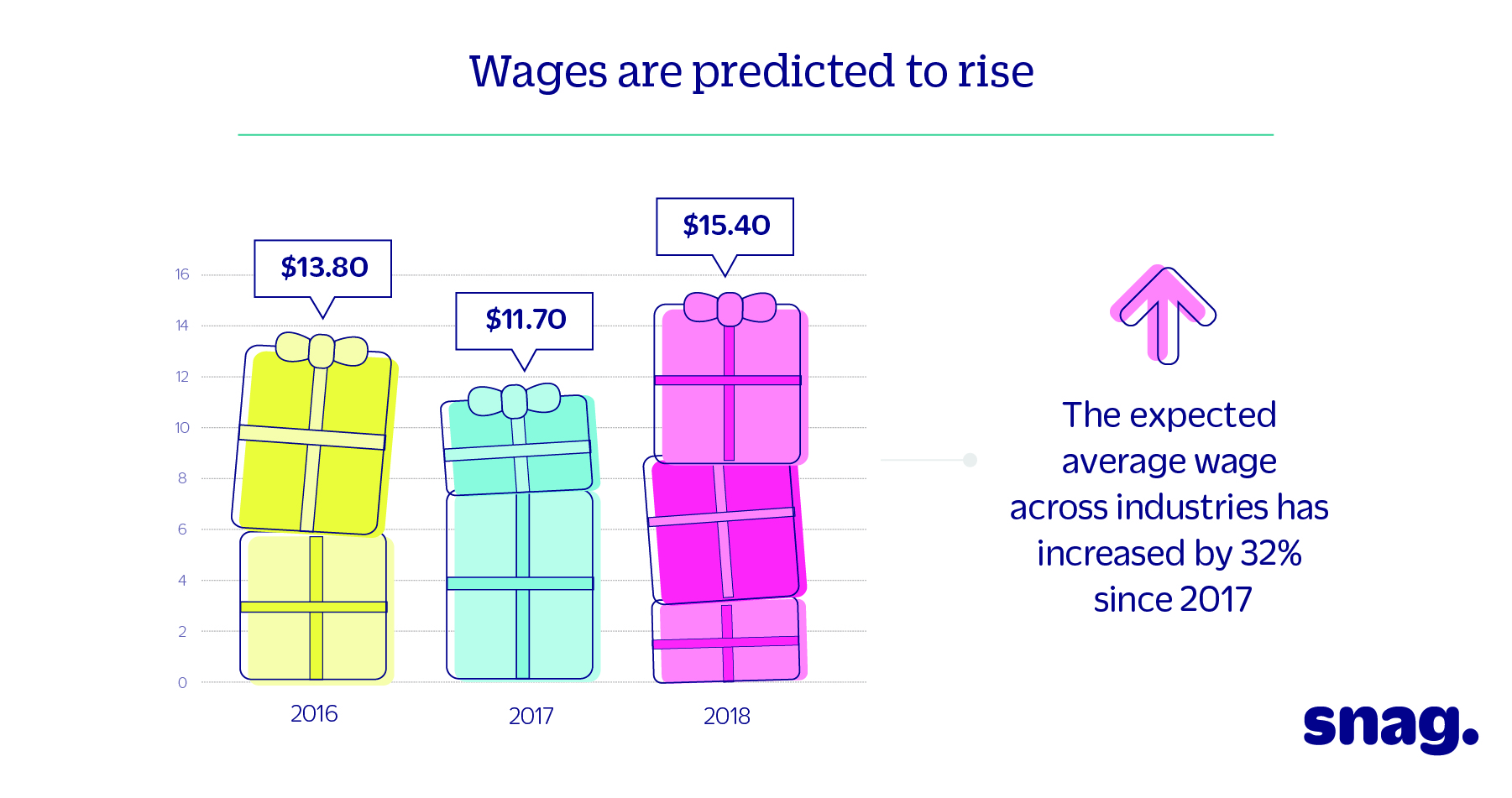
Additional findings from the report include:
-
The number of companies that began recruiting in August or earlier more than doubled compared with last year.
-
In the restaurant industry, the hottest hourly positions this holiday season will be servers, dishwashers and cashiers.
-
Managing employee schedules during the holiday period is expected to be one of the biggest challenges according to 54 percent of employers.
-
The lack of qualified workers and competition from other employers are the major challenges employers are facing as they seek to fill jobs.
-
More than a third (37 percent) of employers expect to rehire between one and five employees from the 2017 holiday season.
-
A majority of employers (62 percent) have increased their use of social media to recruit hourly workers this year.
With more employers saying they’ll need extra workers this year (84 percent versus 77 percent in 2017), the competition for skilled hourly employees is expected to be fierce, and 86 percent of employers say they will struggle to fill temporary seasonal positions. To attract workers, a majority of employers (77 percent) say they’ll be offering perks and benefits including paid time off, training opportunities, childcare, tuition stipends, health insurance, and even transportation reimbursement.
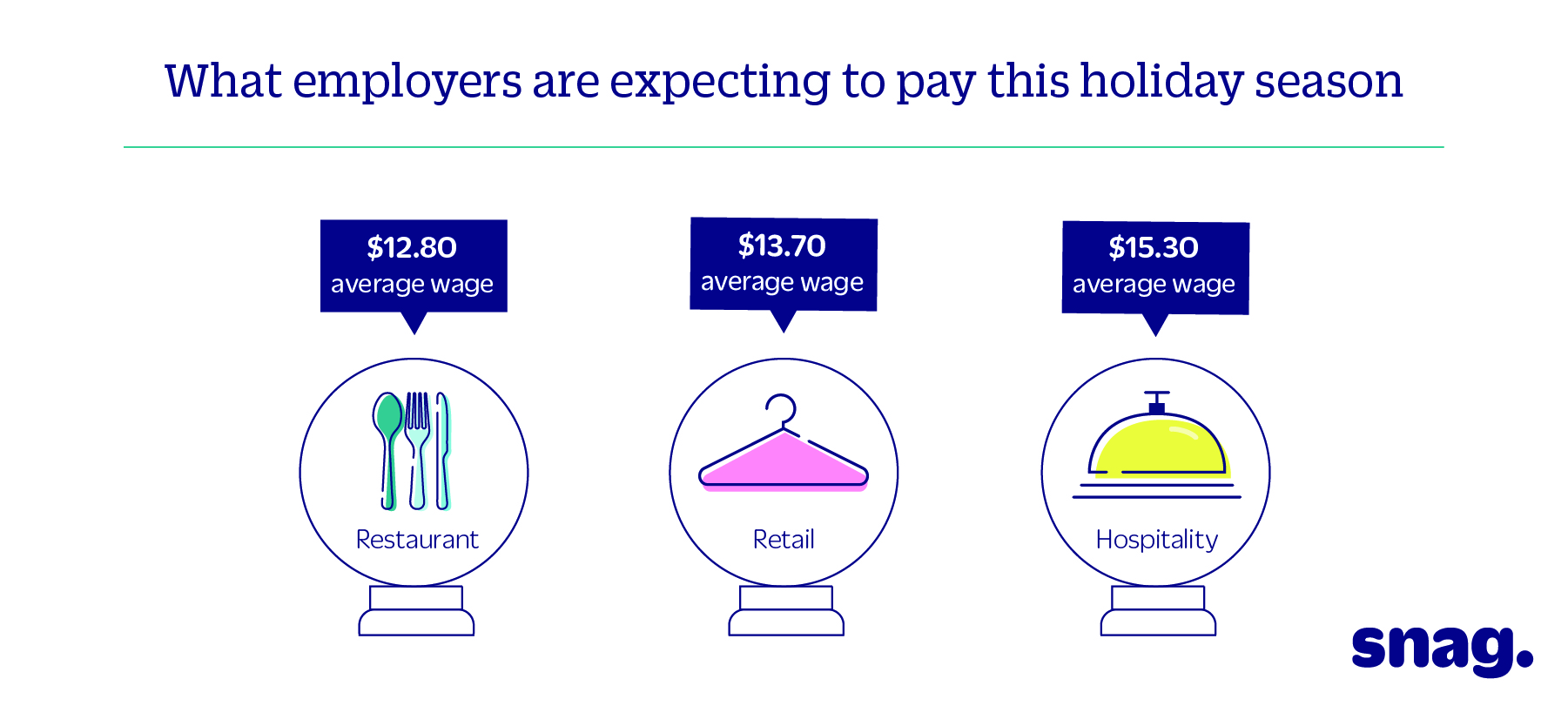
“A growing number of hourly employers understand that having the best workers improves the customer experience and increases revenue,” said Snag CEO Fabio Rosati. “In order to attract and retain the most qualified seasonal workers, many companies are stepping up their game and offering more hours and benefits, higher wages, and flexible schedules.”
"Managers’ anticipation for increased hiring this holiday season reflects optimism about the fourth quarter and the ongoing strength of the U.S. economy. But with unemployment at record low levels, businesses are recognizing that they’ll likely need to offer workers more money and other perks if they are to be competitive in this very tight labor market. That could be good news for workers, who may finally see bigger paychecks after years of wage stagnation,” said Dr. Terry Clower, Director for the Center for Regional Analysis at George Mason University.
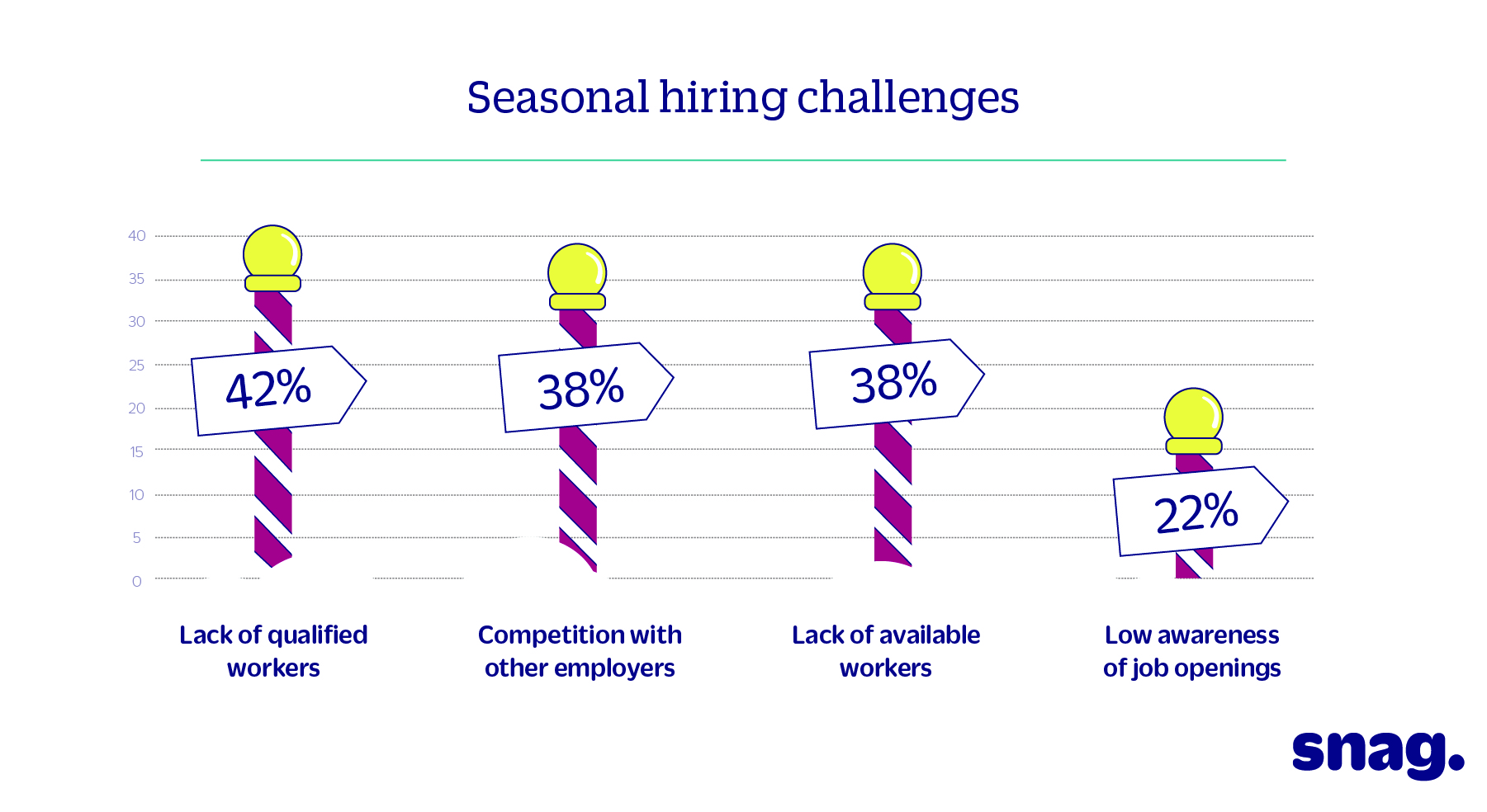
Data for the report was conducted by Wakefield Research, which surveyed 1,000 employers with hiring responsibilities, specifically targeting the nation’s retail, restaurant and hospitality industries.
Snag Report: Expect Fierce Competition for Holiday Hiring posted first on happyhourspecialsyum.blogspot.com
Innovative Solutions for Restaurants to Grow Their Brands
Spending at restaurants in the U.S. has surged over the past few months, with sales at food service and drinking establishments rising 1.3 percent in July 2018 to $61.6 billion. However, industry data shows that restaurant sales are growing while customer traffic declines,suggesting fewer diners eating out but spending more when they do. Although the rise in restaurant spending is good news for the foodservice industry, as the foodservice business becomes ever more competitive and continues to evolve, restaurant managers must find cost-effective and efficient ways to attract new diners and keep repeat customers coming back.
Across the industry, the food delivery business is undergoing rapid change as new online platforms race to capture markets and customers. Since growth in the restaurant industry is coming from those who are dining at home, restaurants are under pressure to attract sit-in diners and still offer a customized experience to delivery customers. Beyond the rise in demand for food delivery, an influx of other dynamics including dining habits, high operating costs and stiff competition mean that restaurants and foodservice businesses need to do more to prove that they can be innovative, flexible and able to adjust quickly to rapidly evolving needs and preferences.
As the foodservice business becomes ever more competitive and continues to evolve …
How can restaurants and foodservice businesses make their mark in an ever-evolving business landscape? For restaurant managers facing the challenge of standing out in a crowded market, delivering a unique customer experience with a lasting impression—creating a “moment” for diners— is critical to increasing customer traffic and bolstering restaurants’ bottom line. A great way to create this customized experience is through tabletop marketing and social media.
Custom touches can go a long way in helping build a restaurant’s unique brand personality and making a mark both inside and outside of the dining room. One way for restaurants and foodservice businesses to add custom touches is by recognizing that everyday tabletop products, such as napkins and napkin dispensers, can double as marketing tools to connect directly with customers.
A recent study indicates that 75 percent of restaurant-goers believe that restaurants with custom print napkins care more about the customer experience and agree that custom print napkins helps them stand out from other restaurants. Digital print is the latest technology that enables full color images, including photographs, to be printed on napkins. Restaurants and foodservice businesses can print custom messages, images and designs on napkins that are used by both customers dining in and take-out customers.
Using napkins as a marketing and promotional tool enables restaurant managers the flexibility and freedom to change the messages they want to communicate to their customers easily and inexpensively. Printing on napkins can serve many different purposes For example, napkins can be printed with messages or designs that grow a restaurant’s brand by conveying their story and history, or they can promote special menu items, discounts and events. For customers ordering food delivery, restaurants can provide napkins that features messages and images that connect them to the restaurant’s brand identity without having to step foot in the restaurant. To convert take-out customers into dine-in customers, restaurant managers can customize napkins with incentives to drive foot traffic, such as coupons that are only valid in-store.
… restaurant managers must find cost-effective and efficient ways to attract new diners and keep repeat customers coming back.
Tabletop marketing is also a powerful tool restaurant managers can use to differentiate their establishment and create a unique environment for their customers while showcasing their efforts to meet customers’ expectations on issues important to customers, such as sustainability. Some napkin dispensers also have display panels, giving businesses even more flexibility to tailor the customer experience with on-premises messaging, which can increase check size and repeat business. Since customers might be less likely to provide return business unless they have a unique experience or are left with a lasting impression of the restaurant’s identity or values, tabletop marketing is a powerful and yet subtle way for restaurants to drive sales and traffic.
To take customization to the next level, business owners and restaurant managers can reach their customers by creating messages through online tools and sharing them on social media. In the digital age with various online food-ordering services coupled with competition to attract a younger demographic, it is more important than ever for restaurants to carve out a place in the market by developing an online presence to distinguish their brand and offerings in order to fill their dining rooms and increase profits. Restaurants can transform traditional napkin dispenser ads into onsite and social media vehicles to showcase menus, promotions, and events to drive and sustain in-store traffic.This gives restaurant managers the ability to share promotions via social media, allowing them to stimulate engagement, reach a wider audience, and boost customer attention and loyalty.
As the food business landscape becomes more competitive, restaurant managers must find creative and innovative ways to maximize profits. Restaurants can ensure that they’re not left in the dust by using marketing solutions that enable them to engage directly with customers and provide an exceptionally unique experience. Customized napkins and napkin dispenser displays that are optimized for social media are a perfect example of how a restaurant can promote its brand and messaging for a better overall impression, service and atmosphere and ensure that they remain ahead of current trends in a cost-effective and impactful way.
Innovative Solutions for Restaurants to Grow Their Brands posted first on happyhourspecialsyum.blogspot.com
Tuesday 25 September 2018
Sign At Your Own Risk: The Sequel … More Critical Lease Provisions to Negotiate or Avoid
In our last article for Modern Restaurant Management (MRM) Magazine, we discussed some of the critical lease provisions contained in a franchisee’s lease which, if not identified and properly negotiated, could have a material impact on the viability of a business. The provisions addressed in that issue – exclusive use protection, landlord’s consent to assignment and continuing liability thereafter, and the landlord’s right to participate in the sales proceeds – only scratched the surface.
In this issue, we present three more highly important provisions, which are often mistakenly (or sometimes even intentionally) overlooked in the rush to finalize a lease and get it signed.
Non-Compete
From the landlord’s perspective, they don’t want a tenant to open another location that might adversely affect that tenant’s sales in the landlord’s shopping center which could adversely impact the tenant’s ability to meet its rental obligations under the lease.
Leases are complicated legal instruments which can be fraught with peril for unsuspecting franchise owners.
This provision, however, can have a detrimental impact on a tenant’s ability to expand, especially a franchisee tenant who may have a development agreement. Landlords who own multiple properties within certain geographic proximity often seek to include a covenant in their leases which restricts the tenant’s ability to open a same or similar business within a certain radius—all in an effort to limit the ability of a tenant in one plaza to impact sales of a competing tenant in another plaza.
Such language may even place a franchisee in violation of his/her franchise or development agreement. For instance, we have seen leases with five mile restrictions on the sale of baked goods and coffee. This would severely impact a franchisee’s ability to develop and optimize its market.
Termination/Reclamation Upon Assignment
Landlords like to include language in their leases which gives them the ability to terminate the lease and recapture the premises if the tenant seeks the landlord’s consent to assign the lease. Landlords will argue that if the original tenant no longer wants or needs the premises, then the landlord should have the right (but not the obligation) to take the premises back and relet it to whomever they choose. This language can make a tenant’s pending assignment a risky, if not impossible, proposition. It is in the franchisee’s best interest to completely delete this language or, at a minimum, provide that the landlord doesn’t have the right to recapture if the lease is assigned to the tenant’s franchisor or to another franchisee.
This is yet another reason why tenants want the right to assign the lease without the landlord’s consent in the first place. If the landlord doesn’t have the right to consent (or not), then it also doesn’t have the right to recapture the premises.
Guaranty
The majority of franchisee tenants form single purpose entities (“SPE”), which have with no assets other than that particular store. If you default, your landlord wants to have someone from whom they can collect rent. This is why the majority of landlords require a franchisee (and, oftentimes, her/his spouse) to sign a personal guaranty. It is rare that a landlord will sign a lease with an SPE and not require a personal guaranty. If you must sign one, the key is to ensure that one or more of the following limitations are in your guaranty: (a) a stated cap on your maximum financial exposure (it can be a fixed dollar amount or, more commonly, limited to X months of rent at the then current rental rate, also known as a “rolling X month guaranty”); (b) a complete release of the guaranty when and if the original named tenant is no longer the tenant under the lease; and/or (c) the guaranty falls away completely after a period of Y years so long as there have been no defaults by the tenant during that time.
Coincident with signing the guaranty, guarantors need to consider their exit strategy. If the tenant sells the store, the guarantor does not want to have continued personal exposure for the acts of a new, unrelated tenant party. For this reason, guarantors are wise to negotiate the Landlord’s release of the guaranty upon the tenant’s assignment of the lease. Naturally, landlords do not like to agree to this but it is worth a hard pursuit in the lease negotiation. A common compromise is to agree that if the assignee and/or its principals have an aggregate net worth of more than $X, then the landlord will release the original guarantor(s).
However you slice the apple, make sure that you do not sign the guaranty without having a full understanding of your maximum potential personal exposure and if (or, ideally, when) you will be released from your guaranty obligations.
Leases are complicated legal instruments which can be fraught with peril for unsuspecting franchise owners. Whenever you enter into a lease for a new or existing franchise restaurant, be certain you are represented by an attorney who is familiar with potentially dangerous provisions.
Sign At Your Own Risk: The Sequel … More Critical Lease Provisions to Negotiate or Avoid posted first on happyhourspecialsyum.blogspot.com
Secrets to Table Service Restaurant Growth (Infographic)
Just how important is customer feedback for restaurants?
The team at Thanx analyzed thousands of table service restaurant customer feedback responses over the last two years and learned some very interesting things including:
- Your best customers matter
- Every customer experience counts
- Replying to feedback grows sales +22 percent
That last stat is powerful as who knew that simply responding to customer feedback could have an impact on your bottom line? This infographic details the importance of feedback and how restaurants can use the data to increase profits and enhance the guest experience.
Secrets to Table Service Restaurant Growth (Infographic) posted first on happyhourspecialsyum.blogspot.com
Monday 24 September 2018
10 Tricks to Solve Workplace Disagreements in Restaurants
A restaurant environment is very dynamic, which is always a fruitful ground for disputes and conflicts among employees. In other words, it’s a living hell for managers who constantly have to play the watchdog role in order to keep the workflow smooth and uninterrupted.
According to the report, US employees spend almost three hours a week dealing with conflicts. It makes a huge impact on productivity, while some workers even have to leave their positions due to improperly managed discords. The consequences can be severe since the cost of hiring and training a new restaurant staff member can reach as much as $3.5 thousand.
In such circumstances, you should learn how to balance between the two conflicting sides. This article will show you 10 tricks to effectively solve workplace disagreements in a restaurant.
Don’t Let the Guests Notice Anything
The basic rule of restaurant dispute management is to keep it all in the kitchen. It’s completely natural to see an occasional workplace quarrel, but restaurant customers are there to relax and have fun – not to watch a couple of staff members arguing and yelling at each other. As soon as you notice something strange is going on, you need to react immediately and solve things internally.
Keep Calm
The next step to take in case of a restaurant disagreement is to tell everyone to calm down. The most important thing is to ensure the normal functioning of your organization, so you can’t afford bigger conflicts. Don’t let the dispute turn into an outburst because your clients could hear it. Besides that, it’s much easier to solve the problem calmly than to scream your way to the solution.
Talk It Over
Sometimes you just have to act promptly, but most of the time you can wait until the end of the shift to discuss the problem. Before you start judging, you should ask both sides a few questions:
What seems to be the cause of this problem?
How did you react to the dispute?
Once you learn what your employees think about this issue, you can take a stand and act accordingly.
Treat Each Side Fairly
Let’s say that one waitress is jeopardizing her colleague’s territory, serving more tables than agreed. The solution is clear in this case – you just need to remind them to stick to the table plan. However, keep in mind to treat both sides fairly, letting them speak their minds freely. After all, you don’t want to lose a good employee because of the minor incident.
Find a Common Ground
As much as it is important to treat each side fairly, it is just as important to find a common ground when solving a disagreement. If a winner takes it all, then a loser ends up devastated. Nothing is ever 100% black or white, so you should each employee satisfied at least to some extent.

If a waiter is serving someone else’s tables, perhaps it’s because he doesn’t like the existing plan and feels underprivileged. In such circumstances, you are the one who should reconsider their positions and perhaps even make necessary corrections.
Keep an Eye on Employees
The first five items on our list were dedicated to conflict-solving, but now we want to focus a little more on prevention. Keep an eye on your employees because it will help you to notice potential problems before the actual outbreak. For instance, people can be angry because of their personal problems. You should get to know your workers and give them a little break if they don’t feel comfortable.
Delegate Tasks Clearly
Another way to prevent trouble in a restaurant is to delegate all tasks clearly and precisely. If everyone knows exactly what to do at any given moment, it minimizes the odds of interpersonal disputes.
Organize Team Building Events
Team building can help you to strengthen relationships within the group, thus improving the overall productivity of your employees. Besides that, team building events often increase people’s motivation to work and inspire collaboration.
At the same time, they serve as creativity and confidence boosters. Using this tactic, you can improve organizational communication, build team culture, and reinforce responsibility as the key factor to restaurant performance.
Don’t Always Interfere
As a manager, you should learn that the workplace disagreement is not a catastrophe. As a matter of fact, sometimes it’s even better not to interfere and let your employees resolve disputes on their own. That way, they will feel more independent, while you can always jump in if you realize that the situation demands your mediation.
Conflicts Are Not Bad
A conflict is a natural consequence of the hectic restaurant environment. Therefore, you should not treat it as a disaster, but rather see it as the opportunity to improve the work process in your team. The sooner you realize it, the easier it will be to handle workplace disagreements in a restaurant.
Solving internal conflicts is crucial for the successful functioning of every organization, particularly restaurants. Restaurant employees keep the direct contact with guests, so it’s critical to keep them polite and motivated.
Make sure to remember our tips – they could help you grow your business, building a better team and raising the level of customer satisfaction.
10 Tricks to Solve Workplace Disagreements in Restaurants posted first on happyhourspecialsyum.blogspot.com
How That Fast Food Menu Could Actually Steal Your Credit Card
Restaurants are loaded with internet-connected technologies and in today’s age of digital transformation, the rate at which new technologies are being onboarded feels like an all-out arms race.
As consumer demand for digital conveniences increases, restaurants are pushed to meet, rather than exceed, expectations for quality, speed and convenience. However, in the rush to keep up and deploy new technologies, more often than not, additional security vulnerabilities are introduced. Restaurants and fast food chains have always been a prime target for cybercriminals due to their high volume of low dollar credit card transactions and typically lagging security posture.
In the past, standard security measures – firewall, antivirus and even encryption – were a solid response to the cyber threats facing diners.
![]()
A successful intrusion into the digital menu board web server could be the foothold a hacker needs to make a hop or two into the POS and begin exfiltrating credit card data.
With the rapid addition of Internet-connected technologies that touch the same network as the point-of-sale (POS) system, new opportunities for credit card data breaches are popping up. Whether that be via the digital menu board, the tabletop tablets, self-ordering kiosks, loyalty program application, guest Wi-Fi, digital inventory tracking, employee scheduling software, or ironically enough, those physical security cameras. The fact is, if one of these systems are vulnerable, your credit card is as well.
So, let’s take that innocent digital menu board for example. The digital menu board is data-driven – what it displays is retrieved from a web server, typically located somewhere else. Typically, that web server is sending data to many stores. That means that digital menu board is connected to the store’s network in order to communicate over the internet, just like the point-of-sale system. A successful intrusion into the digital menu board web server could be the foothold a hacker needs to make a hop or two into the POS and begin exfiltrating credit card data. Such POS intrusions have been known to go undetected for months.
In this example, this situation can be prevented by a few best practices:
- segmenting the network to separate POS traffic from all others,
- deploying cloud next-generation firewall services to ensure security policies stay current and
- using endpoint threat protection on POS systems to immediately be alerted to anomalous and potentially malicious behaviors and events.
As on-premise firewall devices become more expensive and more complex, one critical consideration every store should be considering is managed SD-WAN to roll secure and resilient connectivity, threat protection and PCI DSS compliance into one efficient, simpler and less expensive solution. Through the use of SD-WAN (Software-Defined Wide Area Networking), simpler, multi-purpose edge routers are deployed to the stores while the smarts, such as next-generation firewall protection, intrusion detection and more, are deployed and orchestrated via the cloud.
How That Fast Food Menu Could Actually Steal Your Credit Card posted first on happyhourspecialsyum.blogspot.com
Friday 21 September 2018
Snap, Crackle and Duff
Chef Duff Goldman had a gr-r-reat time concocting magically delicious recipes as part of a culinary residency at Kellogg’s NYC Café in Union Square to benefit No Kid Hungry.
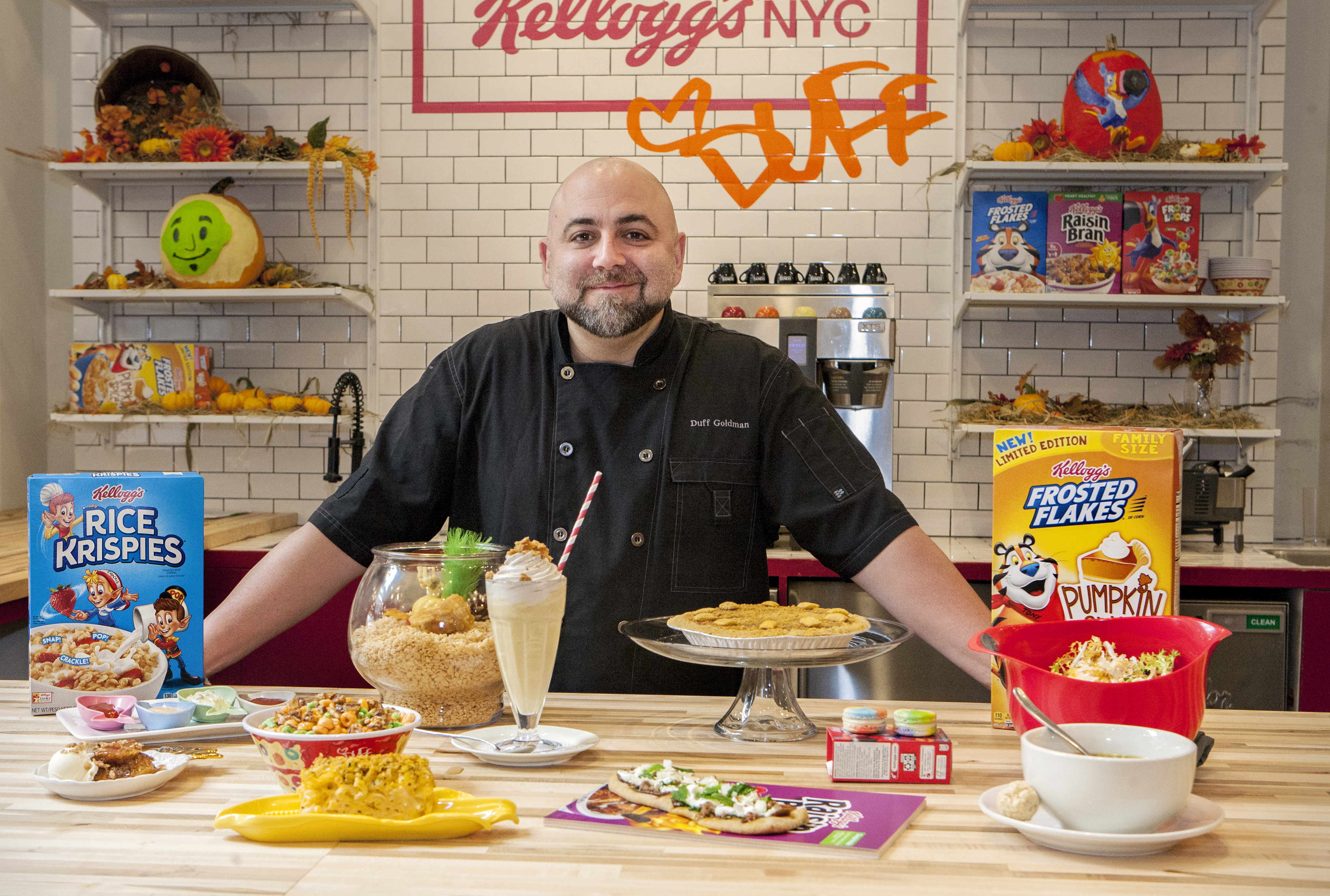
In the MRM News story, the Food Network star details some of the some of the sweet and savory recipes he created such as:
- Chicken Soup with Rice Krispies Matzo Balls
- Kellogg's Krispie Fish Stiks
- Corn Flakes Mac n’ Cheese
- Pumpkin Spice Frosted Flakes Rompope Milkshake: Pumpkin Spice Frosted Flakes custard, cinnamon whipped cream and Frosted Flakes streusel
He also discusses why No Kid Hungry is important to him. During the two-day event, guests were able to “pay what they wanted” to taste the chef's recipes and discover cereal in new ways with all proceeds going to the charity.
Snap, Crackle and Duff posted first on happyhourspecialsyum.blogspot.com
Don’t Over Season the Season: Dispensing a Palatable Serving of Holiday Tunes
Ahh the holidays …
There are lists upon lists. Malls are a veritable decathlon of registers and gift wrap. We’ve all been there, caught up in the frenetic flurry. Perhaps it’s time we capitalize on the mistletoe-induced madness and reconsider the restaurant experience. Truth be told, restaurants are the perfect place to quell the heightened anxiety and provide diners with a relaxing respite during the rush.
So how can restaurateurs curate a seasonal sanctuary for hurried droves of shoppers? Music is incredibly important to the dining experience, especially during the holidays. Yes, restaurants have a revered "experience" to protect. The key is finding the right holiday recipe and serving up songs with mindful moderation.
The Recipe
My advice? Think of holiday music styles as you would restaurant styles. If you’ve decided that holiday music has a place in your dining experience, determine not only how much music, but also look more specifically at genres and styles within the holiday music ecosystem.
For example, an eatery that caters to a large, diverse crowd with strong family business early in the evening might find that diners are more receptive of a pronounced seasonal experience. Think: a Pop-oriented, higher frequency strategy. If the restaurant caters to a refined, upscale crowd with urban sophistication, I’d go with light jazz or vocal accents over more mainstream Pop selections.
Ingredients
Holiday music genres run the gamut and can make a huge difference. While holiday music can be seen as a genre in itself, it’s actually reflective of the style of music from which it draws. Here’s just a few of the many holiday music genres out there: Instrumental Holiday, Latin Holiday, Classic Jazz Holiday, Classical Holiday, Pop Holiday, Christian Holiday and Country Holiday. If you’re ever unsure of what to cue up, just remember, your restaurant’s holiday music must be in concert with your year-round intended experience.
Finding the Right Mix
I think we can all agree that 100 percent of anything can be overwhelming. The same goes for holiday tunes. Mixing in smaller percentages of music over time tends to work better when it comes to retaining your brand personality, tone of voice and the intended experience. I’ve found that the more pronounced, defined or confident a brand is in their personality, the less inclined they are to go with 100 percent holiday music.
Bake Time
So you’ve figured out what genre of music to play and whatpercentage of tunes to sprinkle into your mix, but how about when to cue up seasonal tunes? Holiday mania affords restaurants the unique opportunity to provide shoppers a retreat from overexposure, especially at malls. And while retail stores often opt to start holiday music early, I’d recommend a more metered approach for restaurants. Think of it as a musical advent calendar, with each day bringing a hint more seasonal magic. Slowly increasing the percentage of holiday music over time, especially with regular customers, can prevent an unintentionally jarring experience. Again, your brand identity and intended experience will act as your guide. If you start with the brand or the intended experience first, you’ll be better informed to make the right call.
The truth is, no diner wants to hear 100 percent holiday music 100 percent of the time. Malls are hectic enough during the holidays and shoppers should be able to to kick back at their favorite establishment without hearing the seemingly never-ending ‘12 Days of Christmas’ overhead. As we embark into a season that can sometimes feel over-saturated with all things holiday, it’s important that restaurateurs dispel a measured approach to avoid over-seasoning the season.
Think of holiday tunes like adding salt. Great when sprinkled with intention, yet too much can ruin a perfectly good meal.
Don’t Over Season the Season: Dispensing a Palatable Serving of Holiday Tunes posted first on happyhourspecialsyum.blogspot.com
Thursday 20 September 2018
How App Retention is Like Dating and Getting Engaged (Infographic)
Customer loyalty and retention is important within any industry, but in the restaurant industry it's a crucial aspect of business. As a local establishment, a restaurant will need to impress the people within the community to keep them satisfied and comng back for more.
Working on the relationship with customers with the same level of attention you would to a romantic attachment can help strengthen and grow the relationship.
Working on the relationship with customers with the same level of attention you would to a romantic one can help strengthen and grow the relationship. How a customer perceives their first experience with a company can have a lasting impression. It’s been argued that people have the tendency to make a snap judgment of a person, place, or in this case, restaurant.
Impressing the customer through quality and customer service has a lasting benefit—customer retention. Another benefit of a great experience is the subsequent word-of-mouth marketing efforts patrons will engage in on behalf of the restaurant.
The cost benefits of advertising to an existing customer versus a new customer can be shocking because you might think sales and advertising tactics will function the same across the board. This is not true because people who have experienced the brand previously (especially positively) are more likely to return.
Building a relationship of trust and loyalty with your customers will certainly be beneficial for business. In the visual below, CleverTap outlines how building retention with customers is like dating and getting engaged.

How App Retention is Like Dating and Getting Engaged (Infographic) posted first on happyhourspecialsyum.blogspot.com
Wednesday 19 September 2018
Are Your Customers Coming Back for More?
There's a sushi place a friend of mine loves like crazy. She says it's similar to every other Japanese restaurant in her town, except for one thing: "Every plate is little work of art."
Food arranged like flowers, flowers that are food, elaborate sculptures made of barware, noodles and tea lights – she's so delighted by the operation's "talent, creativity and care," that this restaurant is, to her, synonymous with eating out.
Sixty-one percent of Americans ate out at least once in the past week.
My friend is an engaged customer, the kind every restaurateur needs. Not wants, needs because in today's slow-growth, competitive food service environment, the customer has extraordinary power and reach.
Sixty-one percent of Americans ate out at least once in the past week, Gallup research shows, choosing from an endless list of dine-in and delivery options. Establishments they can choose to post a public review of online — while the food is still hot. And these critiques can go viral in a hurry.
That's real consumer power.
To meet the challenge it presents, restaurants have to deliver a consistent, engaging experience at every single location, on every single channel, every single day, for every single customer.
Engagement Drivers
I mentioned above that my friend is an engaged customer. Gallup defines customer engagement as an emotional and rational attachment to a product or business.
And that engagement? It's lucrative. According to Gallup's research, customers who are fully engaged represent a 23 percent premium in terms of share of wallet, profitability, revenue and relationship growth over the average customer.
To understand what brings customers in and keeps them coming back, leadership needs to understand customers' emotional and rational attachment — and their spending. Emotional drivers aren't about the quality or taste of your food — these are just table stakes in today's world, and any restaurant can replicate them.
Customer engagement is about experience, specifically the way a restaurant makes a customer feel — welcomed by the overall atmosphere, cared for by the friendly service, delighted by the talent and creativity of artistic chefs. Customer experiences should be unique to you, at least a little, but always aligned with your purpose, brand promise and values. Different outlets require different expressions of those things, but whether dine-in, delivery, take-out or catering, the brand experience should be maintained.
Emotional drivers aren't about the quality or taste of your food — these are just table stakes in today's world, and any restaurant can replicate them.
In fact, Gallup data shows that food and beverage customers who are familiar with and aligned with your brand give you 39 percent more share of wallet.
When you have determined the most engaging experiences you can deliver consistently — across all channels and every outlet — correlate them with your customer performance metrics to assess your progress. That's critical for positioning your service operating model.
A winning service operating model is a great differentiator in the competitive U.S. market, but it should be built into the system in foreign expansion efforts, too.
In every case, understand what the data is telling you, create a plan, follow up on that plan and make changes when you need to.
Just don't take your eyes off the data that tell you about your customers' feelings and experiences. A net promoter score tells you if customers are willing to recommend you, which is helpful. But it doesn't reflect customers' emotional engagement, which is a much more powerful driver than overall satisfaction. To that point, fully engaged casual dining customers make 56 percent more visits per month to that restaurant than the actively disengaged do. Fast-food customers make 28 percent more visits.
Those customer metrics and the strategy for how to maximize them are in leadership's hands. But all the data in the world won't help managers unless leadership gives them tools they can use to create a consistent customer experience. One of the most beneficial tools is a system to sustain employee engagement for customer-facing team members. Their engagement numbers are important — and too often undervalued.
That's a serious mistake because the people nearest the customer have considerable power over their experience.
Customer Facing
To a customer, the folks on the floor are the brand promise.
Indifferent team members won't go to the trouble of delivering on the brand promise, and the actively disengaged won't mind if they drive customers away. So customer engagement and experience is downstream from employee engagement, and both largely depend on the local manager: 70 percent of the variance in their engagement comes down to their manager, Gallup finds.
Leadership can help local managers engage team members, deliver a consistent brand experience and ultimately engage customers by doing these five things simultaneously:
- Identify the experiences that create customer engagement.
- Align them with culture, purpose, values and brand promise.
- Make sure they're deliverable across all channels consistently, yet are still specific to the needs of each channel's customers.
- Draft specific, actionable, and correlated behaviors aligned with culture, purpose, values, and brand promise that managers can put into action.
- Hold managers accountable for consistent delivery of these behaviors.
It's a lot, but today's customers expect a lot. In fact, leaders who place employee engagement and customer engagement data in one graph get a resulting picture of what matters most to customers. That's the qualitative and quantitative data that drives your business.
But a manager can only use the tools leadership gives her.
Field support helps by assessing local metrics and reporting them contextually to HQ. But leaders design the systems that sustain culture, employee engagement, customer engagement and the brand promise. If those systems don't support those things, leaders undermine managers — and ultimately, their own business.
The Way to a Customer's Heart
And that's why I used my friend's favorite sushi place as an example. Her response shows that the leadership there is doing everything right. They could go with authenticity, or lower their prices, or flood the market with locations. But those strategies are easily emulated. Instead, they allow their chefs to go nuts with presentation, in a way only their chefs can. To make every meal an engaging event.
My friend's reaction shows it's a winning decision: Every single visit, her plate makes an appearance on her Instagram feed.
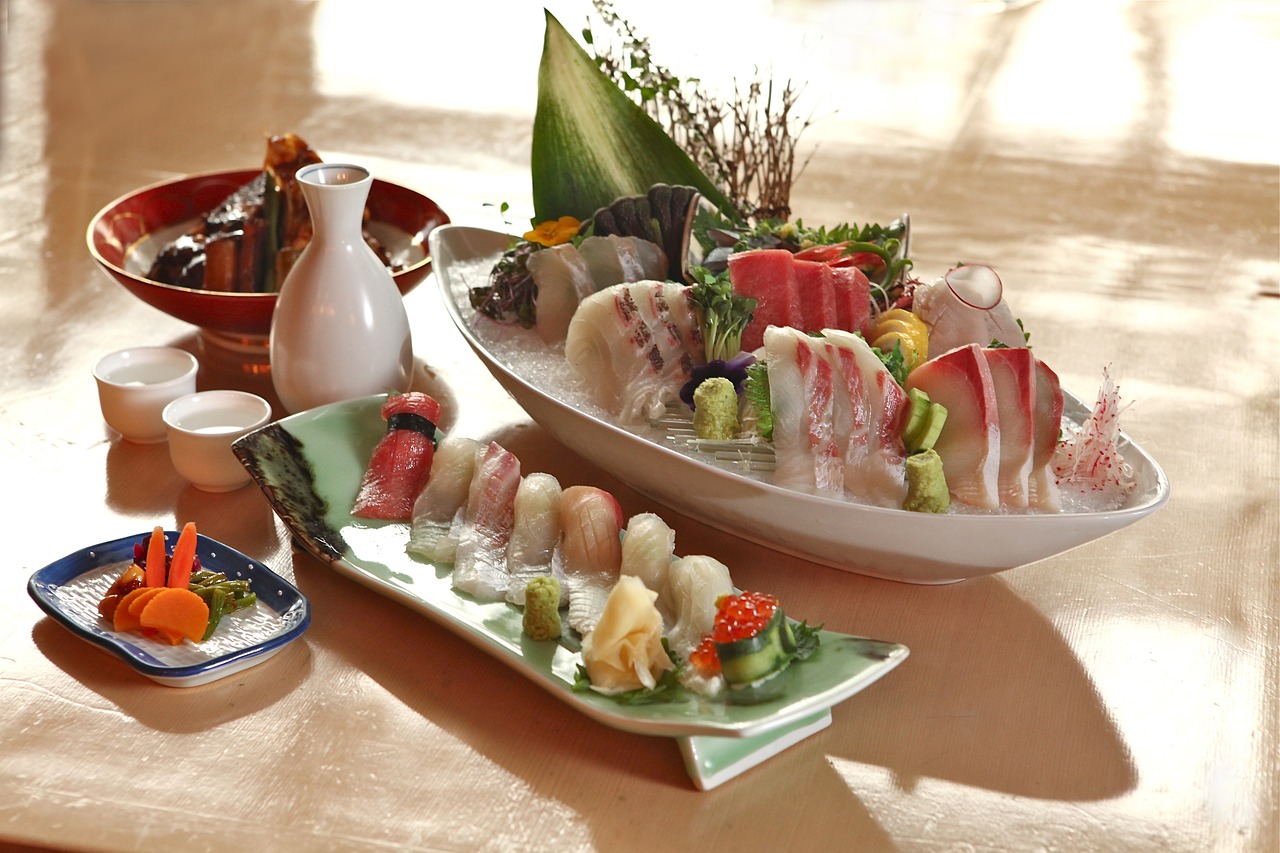
Word of advice — when people gasp and take pictures of their plates, they're building your market for you on social media. Follow their feeds and tell the stories behind the meal to heighten the customer experience. The way to a customer's heart and wallet is by being yourself — and different from every place else — with a consistent, emotionally engaging experience at every single location, on every single channel, every single day, for every single customer.
Are Your Customers Coming Back for More? posted first on happyhourspecialsyum.blogspot.com
Four Cost-Effective Ways to Update Your Restaurant’s Image Right Now
If you haven’t updated your restaurant in several years, now may be the perfect time for a mini facelift to avoid getting dinged in online reviews.
The restaurant industry is growing by leaps and bounds, with 2018 the ninth consecutive year of sales growth, according to the National Restaurant Association. That’s great news for the industry overall, with 60,000 establishments opening their doors annually. But if you’re not the new kid on the block, that’s some stiff competition for you.
We know arenovation can be a huge and expensive undertaking. But don’t worry – you don’t need a major overhaul to upscale your interior. Want to know where to start? The restroom. Seriously. Smart restauranteurs are investing in some simple, cost-effective upgrades that loyal customers (and new diners) notice immediately and respond to positively with lots of repeat visits.
Your restaurant’s restroom is key to your reputation – and your patrons’ experience. People notice and appreciate spotless restrooms. No used, wet paper towels on the floors or sinks? Check. Shiny counters? Check. Maintenance reports on display? Check.
The state of your restroom may rank well above investing in new furniture or front-of-house uniforms and may even determine if diners ever return or recommend you to family and friends. Here are four simple, yet uber-noticeable changes that will go a long way in creating a modern, clean restroom experience for minimal cost and maximum bang for your buck. And, you’ll eliminate waste and reduce maintenance costs.
1. Update Your Fixtures
Customers love automatic, touch-free fixtures, from faucets to soap dispensers. Motion-sensor devices boast the added benefit of energy-efficiency – they only turn on when someone’s using them. Say sayonara to liquid soap dispensers, which can leave a soap string pooling onto the countertop or in the sink.
Consider instead using foam dispensers that drop soap drip-free right into the hand from an automatic dispenser.
2. Invest in Sleek, Modern Hand Dryers
Automatic high-speed electric hand dryers create a touch-free, sanitary environment and reduce waste. The new compact, clean-line, surface-mounted designs dry hands in just 10 to 12 seconds – that’s up to three times faster than older models – and use up to 80 percent less energy. And, these dryers are ADA (Americans With Disabilities Act) compliant.
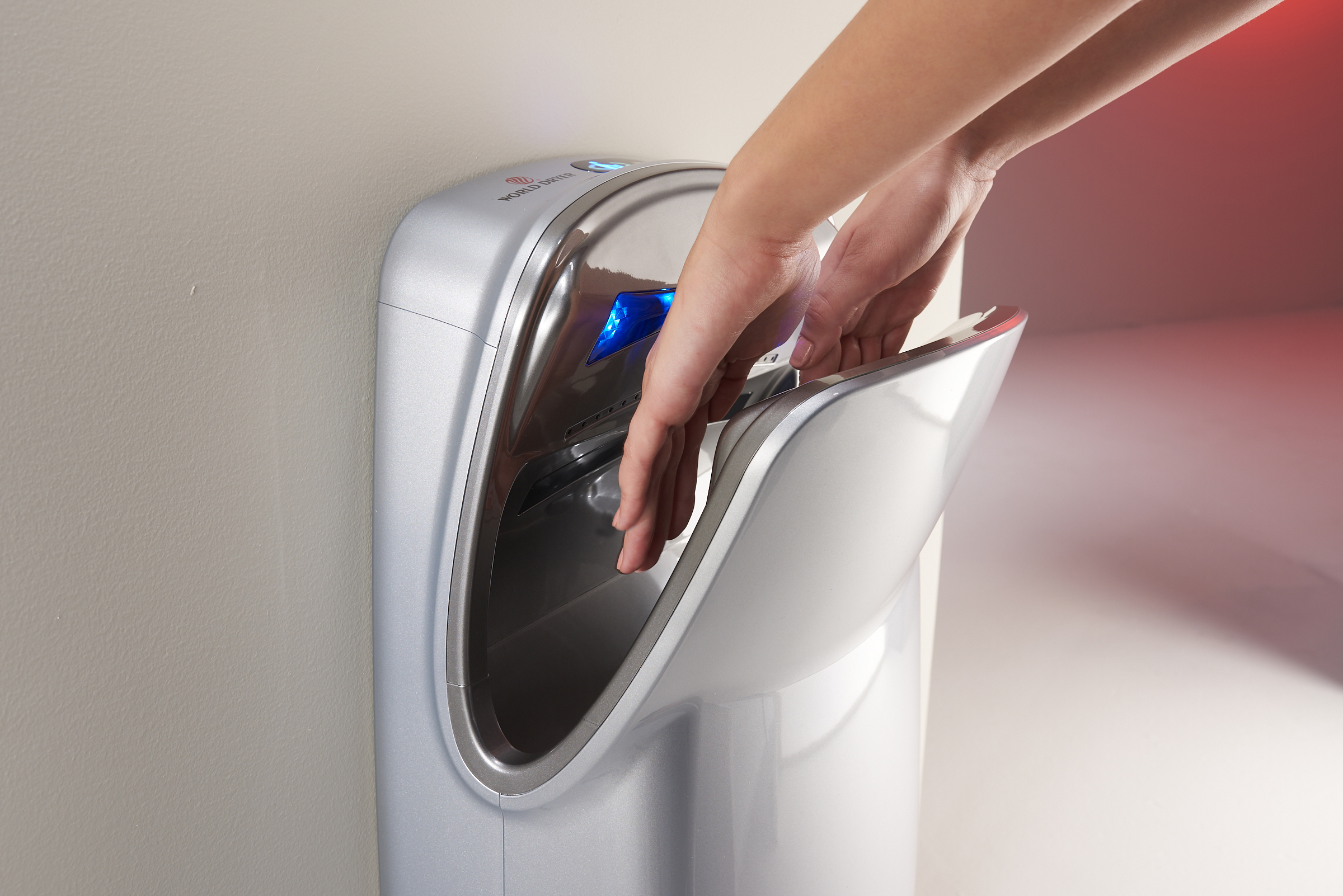
3. Don’t Neglect Trash Receptacles
When used paper towels overflow trash receptacles and scatter on the floor, this creates the potential for serious bacterial growth and makes your restroom appear untidy and unclean.
Solution: Paper-free hand drying options keep your lavatory cleaner and eliminate a patron’s frustration in trying to use a jammed or empty paper-towel dispenser.
4. Ensure ADA Accessibility
Restroom stalls should provide enough space for a wheelchair to properly turn and adjust so all customers can use the facilities in the cleanest possible way.
Tip: Leave a clear floor space 60 inches in diameter in the stall or create a T-shaped space 36 inches wide. Remember to position in-stall fixtures and hand dryers to meet the needs of wheelchair user or multi-person maneuverability.
Additional good news: Your restaurant may qualify for LEEDs Credits
The restaurant industry is buzzing about LEED certification and rightfully so. LEED stands for Leadership in Energy and Environmental Design and is an internationally recognized certification that a building meets high standards for energy savings, water efficiency, emissions reduction and other environmental attributes. The goal of LEED-certified buildings is to provide healthier work environments, contributing to higher productivity and improved employee health and comfort, as well as the savings incurred over time due to the lower-than-industry-standard operational costs. Changing out old fixtures and hand dryers with intelligent, flexible technology fully supports green building and offers a low environmental impact by virtually eliminating waste and maintenance and delivering a more hygienic restroom environment.
Most diners today frequent their favorite establishments for great food, service and ambiance. As you’ve likely seen on HGTV, simple upgrades have the potential to generate a significant return on investment. That’s why improving your restroom’s functionality and efficiency may be all the updating you need beyond your excellent food and service to show customers you care – and keep them coming back.
Four Cost-Effective Ways to Update Your Restaurant’s Image Right Now posted first on happyhourspecialsyum.blogspot.com
Tuesday 18 September 2018
Sign At Your Own Risk: Critical Lease Provisions to Negotiate or Avoid
Negotiating a retail lease is one of the most critical stages in the life of a restaurant.
Each lease presents its own distinct issues and challenges; failing to have significant attention to detail can inadvertently result in an unsuccessful business or impede your growth; one oversight can destroy your succession plan or exit strategy.
Franchisees, often faced with immense market competition and the franchisor’s demanding development requirements, are prone to concede important issues and make careless mistakes in lease negotiations. What follows is a list of critical lease provisions which, if not identified and properly negotiated, could have a material impact on the viability of your business:
Exclusive Use Protection
An exclusive use clause allows you to maintain an edge against competitors by restricting your landlord’s ability to lease space in your shopping center (and sometimes even within a larger area beyond the perimeter of your shopping center) to another tenant who is your competitor.
Each lease presents its own distinct issues and challenges;
When it comes to exclusive use protections, the interests of landlords and tenants are diametrically opposed; landlords want narrow exclusive use language so as to have the most freedom when choosing the tenant mix in their centers; whereas tenants want broad language to ensure that they won’t face competition in their own center or beyond.
Franchisee tenants need to carefully consider exactly what part(s) of their business need protection so that the lease is as precise as possible. When negotiating this provision, tenants must be sure that the lease not only expressly requires the landlord to enforce the tenant’s exclusive, but also addresses the tenant’s remedies if the exclusive use is violated. Failure to addresses these points renders the protection granted by the provision essentially meaningless.
Landlord’s Consent to Assignment and Continuing Liability
As a tenant, your ability to assign your lease to a third-party has a direct impact on your ability to sell your business and ultimately realize a return on your investment. Like exclusive use protection language, assignment provisions are another instance where the landlord and tenant have conflicting needs. Landlords seek to exert extreme control over the transfer of their leases so as to ensure the qualifications and viability of the assignee tenant. Contrarily, tenants look for the ability to freely assign the lease so as to minimize any delays or road blocks to the exit of their businesses.
Failing to have significant attention to detail can inadvertently result in an unsuccessful business or impede your growth;
Landlords will often seek to maintain the right to approve or reject the proposed assignee, in their sole discretion. At a bare minimum, franchisee tenants should seek to tie the landlord’s ability to approve an assignment to a standard of reasonableness, thus curtailing the landlord’s ability to reject a proposed assignment. Ideally, if possible, the franchisee tenant should negotiate the ability to assign the lease as of right (i.e., without landlord consent), to their franchisor, to other approved franchisees within the same system, or to any other party who purchases all or substantially all of their assets.
Related to the need to address landlord’s consent to assignment is the need to address whether or not the assigning tenant and any then existing guarantor have continued liability for tenant obligations which accrue after the assignment. Landlords will always seek to collect as many potential obligors as possible and typically require that, even if they consent to an assignment of the lease, the tenant and guarantor will remain liable under the lease. From the landlord’s perspective, multiple obligors ensures that the landlord has a long list of parties to sue in the event of a tenant default, thereby increasing their chances of actual collection. It is critical for a tenant to negotiate, up front, the tenant’s release as well as the release of any then existing guarantor upon an assignment of the lease. As a compromise, again, franchisee tenants should, at a minimum, seek to tie their release to certain minimum thresholds (such as the net worth of the assignee tenant and its principals, in the aggregate).
Right to Participate in the Sale
Landlords often seek to retain the right to share in the sales proceeds when their tenants sell their businesses, stating that it is only because of the landlord’s property that the tenant has a store to sell in the first place. We have seen leases where the landlord is entitled to up to 50 percent of the sales proceeds. Failing to address this properly can result in the tenant not being able to afford to sell its business because it won’t be able to keep enough of the sales proceeds.
One oversight can destroy your succession plan or exit strategy.
Given that it is the tenant, and not the landlord, who uses blood, sweat and tears to grows its business and make it saleable, at a minimum, the lease should provide that the landlord is not entitled to any portion of any monies received by the tenant in connection with an assignment of the lease to the tenant’s franchisor or another approved franchisee. Ideally, this provision should be deleted completely and the lease should expressly state that the landlord is not entitled to any portion of sales proceeds under any circumstances, period.
These are some of the most important steps franchisees must consider in any lease, but there are more. We will examine non-compete clauses and what happens when your landlord tries to terminate your lease and recapture your premises in an upcoming article on Modern Restaurant Management (MRM) magazine.
Sign At Your Own Risk: Critical Lease Provisions to Negotiate or Avoid posted first on happyhourspecialsyum.blogspot.com
Fine Dining Marketing Framework (Infographic)
Consider the following statistics about fine dining restaurants.
- Since 1987 the share of consumer spending on live experiences and events relative to total U.S. consumer spending increased 70 percent.
- 80 percent of Millennials want to know more about process and origins — how their food is grown and where it’s sourced.
- 81 percent of consumers search for restaurants through mobile apps and 75% make decisions from their search results.
- Customers expect real-time engagement with restaurants. 50 percent of diners expect a response in less than an hour.
- 72 percent of travelers will search for restaurants on their smartphones while on vacation.
- Millennials and generation Z spend more money eating out than any other generation, with 54 percent dining out at least three times a week.
Diners are not just looking for top notch experiences but also ways to engage and share those experiences through their digital lives.
Diners are not just looking for top notch experiences but also ways to engage and share those experiences through their digital lives.
How do restaurants respond to the clear shift to online for today's diners? We propose a framework restaurant managers can use to kickstart their marketing initiatives. Whether it's for a new concept or to re-invigorate an existing restaurant you can use this framework to take the next step with marketing a fine dining restaurant.
The framework has two parts. The first is the technology that currently exists restaurants must leverage in their marketing. The second is the ways in which restaurants appeal to today's diners. The framework demonstrates how all these areas interconnect to produce a coherent restaurant marketing strategy.
Great fine dining restaurant marketing requires restaurants to have a deep understanding of how technology, values and marketing interconnect. Restaurant marketing is digital first and restaurants are setting themselves up for success with CRM and restaurant reservation software that helps find and retain new customers. Social media has infected all elements of the restaurant experience, with diners looking to become part of the conversation. Restaurants can setup their marketing to encourage existing customers to promote the restaurant themselves and rely less on strategies like advertising.

Fine Dining Marketing Framework (Infographic) posted first on happyhourspecialsyum.blogspot.com
How to Win Every Customer’s Heart
Every service industry wrestles with one problem that is central to everything else we do. We pay a lot of advertising money to draw people ...

-
Every service industry wrestles with one problem that is central to everything else we do. We pay a lot of advertising money to draw people ...
-
This edition of Modern Restaurant Management (MRM) magazine's Research Roundup features F&B companies views on mobile technology, ...
-
McDonald’s recent acquisition of decisioning engine Dynamic Yield for $300 million is a clear indication of the vital importance of personal...